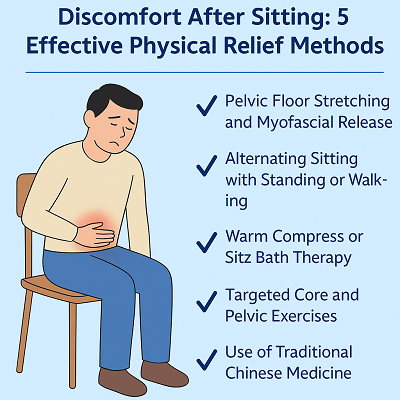Chronic Prostatitis and Lower Abdominal Discomfort After Sitting: 5 Effective Physical Relief Methods
Chronic prostatitis is a common urological condition that affects millions of men worldwide. One of the hallmark complaints among sufferers is a sense of heaviness or dull aching in the lower abdomen, especially after prolonged sitting. This symptom, though subtle at times, can significantly impact quality of life. In this article, we’ll explore the physical causes behind this discomfort, and more importantly, discuss evidence-based physical methods to relieve it, with practical tips you can apply daily.

Why Does Prolonged Sitting Worsen Chronic Prostatitis Symptoms?
Chronic prostatitis/chronic pelvic pain syndrome (CP/CPPS) is a multifactorial condition involving inflammation, pelvic muscle dysfunction, and nervous system sensitization. Prolonged sitting, especially on hard surfaces or in a slouched posture, worsens these factors by:
- Compressing the perineum, increasing pressure on the prostate and pelvic floor muscles.
- Reducing blood circulation to the pelvic region, slowing inflammation resolution.
- Tightening pelvic floor muscles, leading to myofascial trigger points and referred pain to the lower abdomen and groin.
A study published in PubMed found that men with Chronic Prostatitis/Chronic Pelvic Pain Syndrome (CP/CPPS) often experience increased pelvic floor muscle tension during prolonged sitting, which can aggravate symptoms like lower abdominal heaviness and perineal pain. Clinical evidence supports that physical therapy and posture adjustments can effectively relieve such discomfort. (1)
Top 5 Physical Methods to Relieve Lower Abdominal Heaviness
Here are five non-drug physical strategies, supported by clinical and practical experience, to ease abdominal heaviness and promote prostate health.
1. Pelvic Floor Stretching and Myofascial Release
Pelvic floor tension is a key contributor to CP/CPPS symptoms. Gentle stretching helps relax the muscles and improve blood flow.
Recommended Movements:
- Happy Baby Pose (Yoga): Lie on your back, bring knees toward your chest, and hold your feet with your hands. Hold for 1–2 minutes.
- Kneeling Hip-Flexor Stretch: Step one foot forward and lunge gently, opening up the pelvis and groin.
According to the American Urological Association, myofascial physical therapy significantly reduces CP/CPPS-related pain and pressure (2).
2. Alternating Sitting with Standing or Walking
Long hours of sitting should be broken up with standing or walking breaks every 30–45 minutes. Even brief movements improve circulation and reduce pelvic congestion.
Suggestions:
- Use a sit-stand desk.
- Set phone reminders to stand and stretch.
- Walk around for 2–3 minutes each hour.
Bonus Tip: Try walking after meals—it promotes both digestion and pelvic drainage.
3. Warm Compress or Sitz Bath Therapy
A warm sitz bath or compress placed on the lower abdomen or perineal area can help relieve muscle tension and promote local blood flow.
Instructions:
- Fill a basin with warm water (around 40°C), sit for 15–20 minutes.
- Do this 1–2 times daily, especially after work or before bed.
Warm water therapy has been shown to ease pelvic muscle tension and lower abdominal discomfort in CP/CPPS patients, as documented in Urology Journal (2020).
4. Targeted Core and Pelvic Exercises
Strengthening the deep abdominal and pelvic muscles helps stabilize the pelvis and reduce strain on the prostate area.
Effective Exercises:
- Diaphragmatic Breathing: Promotes relaxation and reduces tension in the pelvic floor.
- Bridges: Strengthens glutes and core without straining the prostate.
- Pelvic Tilts: Mobilizes the lower back and pelvic region gently.
Aim for 10–15 minutes daily. Avoid high-impact or abdominal crunches which may worsen symptoms.
5. Take Traditional Chinese Medicine for Treatment
Physical strategies work best when combined with natural therapies that address internal inflammation and pelvic congestion. One such herbal approach is the Diuretic and Anti-inflammatory Pill, a traditional Chinese medicine formulation used widely for prostatitis and pelvic inflammation.
Its unique blend of anti-inflammatory, antibacterial, and circulation-promoting herbs helps:
- Clear heat and dampness in the lower abdomen.
- Relieve swelling and congestion of the prostate.
- Restore urinary function and reduce pressure symptoms.
Many users report a reduction in heaviness and discomfort within weeks when combining physical therapy with herbal treatment. Learn more or consult a specialist via www.diureticspill.com.
Bonus Advice: Improve Sitting Ergonomics
If your work requires long hours at a desk:
- Use a cushioned seat or donut cushion to reduce perineal pressure.
- Keep hips level with or slightly higher than knees.
- Avoid slouching; maintain a neutral spine.
- Place feet flat on the floor.
Over time, better posture reduces muscle tension and prevents recurrence.
When to Seek Professional Help
If your abdominal heaviness persists despite physical therapy, consult a urologist or pelvic health physiotherapist. Imaging or lab tests may be needed to rule out infections, cysts, or other underlying causes.
Also consider a consultation if you experience:
- Burning urination or frequent urge
- Blood in semen or urine
- Severe perineal or lower abdominal pain
Conclusion
Chronic prostatitis is a complex condition, and lower abdominal heaviness is one of its most frustrating symptoms. Fortunately, with consistent physical self-care, attention to posture, and supportive natural medicine like the Diuretic and Anti-inflammatory Pill, many men can experience lasting relief.
Proactivity is key—move often, stretch gently, and treat the root causes, not just the symptoms.
References
1. Impaired Ability to Relax Pelvic Floor Muscles in Men With Chronic Prostatitis/Chronic Pelvic Pain Syndrome
2. Prevalence of Myofascial Chronic Pelvic Pain and the Effectiveness of Pelvic Floor Physical Therapy



